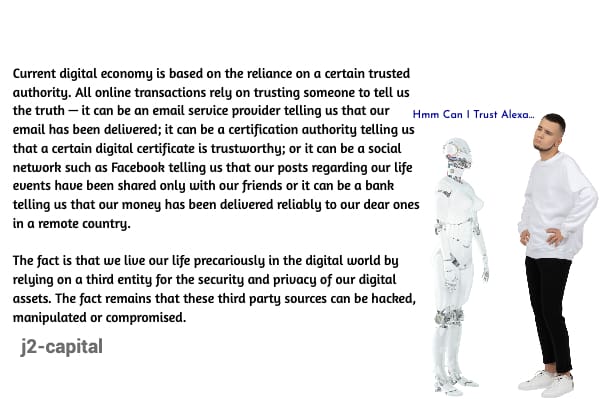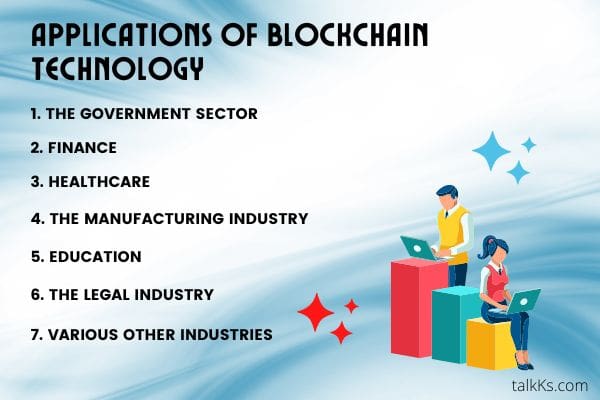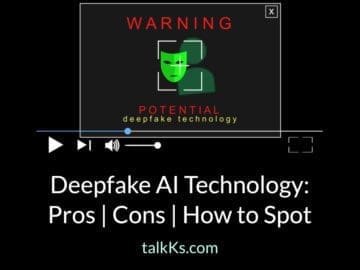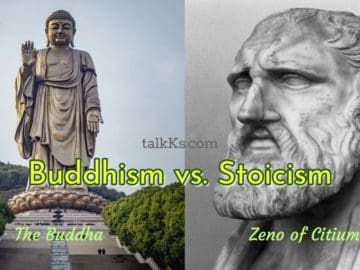Table of Contents
Each generation experiences a grand phenomenon that revolutionizes the way the world operates forever. The most recent was the emergence and rise of Bitcoin as well as other subsequent cryptocurrencies. Blockchain Technology is the foundational element behind Bitcoin. As we approach the 3rd decade of the 21st century, the potential of this marvel technology transcends cryptocurrency. This article will explore these possibilities, with a minor focus on how it can help to break up big tech monopolies and create a fair decentralised tech space for all the internet users.
Blockchain is a decentralised system of storing information that preserves the provenance of original data. The name “Blockchain” is a combination of the words “Block” and “Chain”. A blockchain consists of packages of information known as “Blocks” that are each linked to the one before, thus creating the Blockchain illusion.
These blocks can hold a myriad of information in digital forms such as financial transactions, property records, legal contracts, medical information, and many others. Each complete block is tied to its nonce, a 32-bit arbitrary number randomly generated when the block is created, and its hash, a 256-bit identification number generated by the nonce. This hash can be described as the digital equivalent of a human fingerprint, due to its uniqueness.
The history of Blockchain technology can be traced back to the early 1990s when cryptographers Stuart Haber and W. Scott Stornetta tried to establish a system with tamperproof document timestamps. However, the first practical utilization of blockchains did not occur until January 2009, when Satoshi Nakamoto, the pseudonymous creator(s) of Bitcoin, launched the now-infamous cryptocurrency.
One of the prominent properties of blockchain technology is its ability to be used as a distributed ledger, as demonstrated by bitcoin. In this model, bitcoin is managed by a peer-to-peer network of devices (known as “nodes”) geographically spread all over the world. These nodes are operated by separate, independent individuals or groups, as opposed to a distributed database with a central administration or authority. This decentralization allows the blockchain to be resistant to any altercations to its previously recorded information, meaning the data recorded in the blockchain (in bitcoin’s case, transaction history) is irreversible.
On a public blockchain like bitcoin, the decision to add new information is made by consensus. When a majority of nodes on the blockchain verifies that the information is valid, it is added to the chain in the form of a block. Each block’s position on the blockchain is based on the chronological order of creation. Therefore, each block contains the exact timestamp of its creation, its hash, as well as the hash of its predecessor. If any changes are made to the information in a block, its hash and the timestamp also change automatically. This makes it impossible to tamper with the data on the blockchain. If a user alters their copy of the blockchain, other nodes on the chain could easily cross-reference their copies and identify the node responsible as well as correct the change. This fault-tolerance mechanism builds trust in each block in the history of the blockchain and gives the users the platform to interact with the data in real-time without relying on intermediary third-parties such as banks, lawyers, brokers, etc.
The whole point of using a blockchain is to let people – in particular, people who don’t trust one another – share valuable data in a secure, tamperproof way.
MIT Technology Review
Due to this transparent, decentralized nature of a blockchain network, any adjustment to the system operation or the data it contains requires consensus, which ensures these changes are made in the best interests of the majority (Blockchain distributed consensus model). Moreover each and every online transaction involving digital assets, past and present, can be verified at any time in the future. This brings us to the first point in our list of how blockchain technology can immensely underpin the way we do online activities in coming years.

How blockchain technology can break current big-tech monopolies
We are currently witnessing the incessant rise and unparalleled dominance of big-tech giants. In 2019, Apple, Alphabet, Amazon, Facebook, and Microsoft generated combined revenue of $899.2 billion. For reference, if those 5 big-tech companies were to aggregate into a single country, it would be the 18th largest country in the world by GDP[1]. With the majority of the population now believing the tech companies should have their powers limited[2]. it has become evident that a technological solution to break up the tech giants stronghold on our society is just as needed as government-imposed regulations. This is where blockchain technology comes into play. Steem is a new kind of social media platform that’s powered by Blockchain tech and the competition in this space is heating up!
Protecting Privacy
If there was a competition for the world’s worst kept secret, social media companies and search engines accessing our private data would be the odds-on-favorite to bring the trophy home! Everything from personal conversations to search queries we enter to advertisements we click on is tracked, recorded, and stored. A blockchain-based system could prove to be a fine antidote to this treacherous predicament. As cryptocurrencies such as Bitcoin, Ethereum, and IOTA have demonstrated, combining cryptography and economic incentives can establish an unbreachable way of storing and accessing the private information of anonymous users. Blockchain networks with special cryptographic functions can enable the protection of information and manage who can access it by allowing varying degrees of confidentiality. Blocksurvey.io is an example of such a network. It implements a blockchain system that prevents your personal information from being shared when you’re answering a third-party survey.
Fighting Fake News
Fake news and clickbait have infested our orthodox social media feeds. A survey held in spring 2020 showed that 60% of 16-to-24-year-olds in the UK had recently used social media for information about the coronavirus, and 59% had come across fake news on the subject[3]. The situation across the globe is not any better. A Reuters Institute report for the University of Oxford’s Study of Journalism accounts that 55% of readers are concerned about online misinformation. The related YouGov survey which featured 75,000 people from 38 countries across all continents has uncovered the disquieting fact that less than half of people (49%) trust the news media they use themselves[4].
So why aren’t these social media powerhouses not taking sufficient measures to tackle this? Is it because they are not equipped with a technique capable enough to mitigate and verify millions of pieces of information posted within mere minutes? Or is it because fake news and clickbait drive up engagement and more engagement equals more money? Well, it’s a bit of both. Here, the transparent nature of a blockchain ledger becomes the wildcard.
According to Avivah Litan, the co-author of the “Predicts 2020: Blockchain Technology” report, By 2023, up to 30% of world news and video content will be authenticated as real by blockchain ledgers, countering Deep Fake technology[5]. As blockchains continue to make swift and palpable moves through the world of technology, we might be heading towards a fake news-free social media networks.
Combating censorship
Big tech oligarchs have been under increasing scrutiny lately regarding their enforcement of rigorous online censorship and demonetization. While the global conversation regarding the threat to free speech from big-tech monopolies gets heated, Chinese internet users have already deployed blockchains to resist the heavy censorship implemented by the governing Chinese Communist Party. Several blocked letters and reports have been published on the Ethereum blockchain by anonymous users. Since Ethereum transactions are permanent and distributed among many computers in public decentralized networks, anyone could read the materials, and the CCP was unable to tamper with the information or force ISPs to remove them[6]. While it must be noted that the Chinese state-led censorship vastly differentiates from the big-tech companies’ censorship, the principle of utilizing blockchains to fight online censorship can be adopted by any platform wishing to supersede current social media heavyweights.
Paving new avenues for getting paid
Social media content producers have long been resigned to losing well-earned money to media platforms acting as the middle-man. A blockchain network that features a goal-based financial incentive system can eliminate this problem and allow individual creators themselves to gain agency over their content as opposed to a central media platform. A blockchain-based video sharing platform could rival YouTube in the future by adopting this theory.
Ranidu Lankage’s blockchain-based music streaming service Audius has already incorporated this idea to its core. The innovative Sri Lankan DJ’s platform will allow users to spend tokens to listen to songs as it seeks to cut out the middle-man in streaming and pay up-and-coming artists their fair share. Wordproof and Open Music Initiative are organisations that use blockchain tech as a way to protect copyrights of web content creators.
Furthermore, businesses could have the opportunity to streamline their transactions and payment processes using “smart contracts”, a series of programs that are stored on a blockchain and can be used to automatically exchange rewards based on certain conditions and criteria.
Conclusion
With big-tech titans continuing to tread on wafer-thin ice using their unmitigated power, blockchain developers’ mission to disrupt and cripple these monopolies and establish a more decentralized web would certainly be one to keep an eye on for the next decade. Cue the avalanche effect.
Let’s now look at applications of Blockchain technology
Blockchain tech can be useful in many sectors. Here we have listed some of the common applications.

Applications in the Government sector
1. Implementing an entrusted voting system for democratic elections
With the hotly-contested 2020 US Presidential Election reigniting the age-old public discourse regarding voter-fraud, there has probably never been a better time to look into permanently applying blockchain technology to create a secure voting system. The immutable nature of the blockchain would guarantee the eradication of ballot-tampering as well as eliminate the need for manual counting, thus delivering faster election results. Moreover, the ability to cast your vote digitally in the form of a cryptographic unit or token would void the need to be physically present in order to vote. This will help boost voter turnout. Additionally, the transparency and traceability that blockchain offers will widely decrease public distrust related to the validity of the ballots and election results in general, and prevent the need for further audits. Needless to say, all things considered, a blockchain-based voting system would be a significant overhaul to the currently outdated traditional voting systems. Voatz is one such company that’s researching on this area.
2. Storing Public Data
Government databases are almost always the largest single record of information on its citizens. They record, store and manage individual’s data on a plethora of different factors from birth to death. This makes them very attractive targets for hackers and other bad-faith actors. A blockchain network can help reduce this threat significantly. The decentralization will not only provide resistance to a potential breach or data remodification, but it will also add better transparency to the database. Furthermore, a blockchain structure would help the general public navigates these databases more smoothly and efficiently.
Applications in Finance
3. Reducing Cross-border transaction Costs
Cross-border transactions typically prove to be expensive and time-consuming. This is mostly due to having to pass through security clearances and make stops at multiple banks along the way. A blockchain-inspired method like Bitcoin would accelerate this process and help reduce transaction costs and fees. This means no more reliance on PayPal!
4. Verifying digital identities
With 91 percent of banks, worldwide have started to invest in blockchain-inspired solutions, it won’t be long before they will be able to authenticate the identity of a unique customer using blockchain IDs. This will allow them to protect their institution as well as their customer from scammers and other fraudulent personnel. Hydrogen Platform is a great example of an online source that uses blockchain properties to facilitate digital identification, among other financial services. Evernym is another company that provide similar service.
5. Crowdfunding
A blockchain system that deploys smart-contracts will be able to eliminate the third-party platforms that currently run crowdfunding programs. This will allow the donors and recipients to deal directly with each other as well as save the intermediary fee.
6. Equity trading
Due to blockchain networks’ ability to verify and confirm transactions swiftly, it has the potential to overtake current equity trading platforms by offering a much faster trading experience for their clients.
Applications in Healthcare
7. Protecting Medical Data and Patient Privacy
With a staggering 176 million+ personal health records being accessed by intruders between 2009-2017,[7] it’s fair to say that data security has become a major concern within the healthcare industry. Blockchain networks’ version of an immutable, decentralized patient detail log would be able to facilitate a significantly better and more secure healthcare database. BurstIQ is one of the companies that heavily research in this area.
8. Advancing Genomics
Genomics is a branch of molecular biology that studies the structure, function, evolution, and mapping of genomes. As scientists continue to achieve crucial breakthroughs in this remarkable field, blockchain systems can help them by providing the digital infrastructure to store billions of genetic data. It can also provide open-source markets where people can sell their encrypted genetic information to researchers.
Applications in the manufacturing industry
9. Monitoring Supply Chains
The decentralized ledger format can be utilized to track containers during the shipping process. Every crew member in the supply chain has access to the information and they can perform their job accordingly. If used properly in a similar logistical function, this technology can drastically reduce the human effort and paperwork required to complete the task. IBM recently concluded an initial test of the application with favorable results. ShipChain is a company that operate in this space.
10. Internet of Things
Internet of Things (IoT) refers to a network of wirelessly connected physical objects that can share data through the internet. The idea of a blockchain application to verify the integrity of both data and the devices in such a network is quite promising.
11. 3D printing
3D printing is an intriguing innovation by itself, however, using a blockchain method to manage its supply chain simply takes it to the next level. The blockchain facilitates every function in the process with no middle-man. From encrypting the design to negotiating a printing deal via smart contracts to final product information and ownership details.
Applications in education
12. Facilitating an advanced student registry
Unsurprisingly, blockchain’s components can be harnessed for educational purposes as well. Using the immutable distributed ledger, administrators can establish and manage a database that consists of invaluable academic information on each student. This information can be accessed to identify the problems students experience, and put forth necessary actions or teaching techniques required accordingly. Even further, by using the decentralized structure of the blockchain, this data can be shared among parents, educators, and even multiple schools or universities. Apart from this, student data can be easily verified to ensure the accuracy of each student’s credentials and achievements.
13. Motivating students through a token-based reward system
Tokenized digital credits or even cryptocurrencies can be used as incentives for both students and teachers to improve morale and advance their academic potential. Teachers can present the best performers with extra (digital) credit as a form of encouragement and cultivate an enthusiastic learning environment.
14. Creating an educational achievement portfolio
A blockchain network that stores students’ academic accomplishments and merits can help them build a transparent digital CV, which, when presented to a future employer, can be verified by checking with the school or university administrator. APPII is a blockchain-based recruitment platform that allows students to create their portfolios. Once the student enters his or her academic details and milestones, a blockchain network verifies the accuracy of the input credentials, and machine learning is occupied to match the data in the CV to relevant job opportunities.
Applications in the legal industry
15. Notary function
Blockchains are a great way to keep track of things over time while preserving original data and transparency, right? So, it is undoubtedly the perfect digital notary. Recording legal documents related to intangible assets like intellectual property, royalties, wills, art, copyright agreements, and patents on a blockchain network would make it extremely easy to confirm and verify the validity of those documents whenever necessary. Stampd.io is a website that allows you to add documents to a crypto blockchain, setting up the chance in the future to prove that it was added by you with an exact timestamp. A non-fungible token (NFT) is one of those modern investment asset class that’s popular among crypto traders these days. Most NFTs are part of the Ethereum blockchain so you need to have some Ethereum in order to get into this kind of investments.
16. Managing Real estate transactions
The information regarding tangible property registration and transfer of ownership rights can be efficiently managed through a blockchain ledger. Since the data stored on the blockchain is fully transparent and immutable, any conflict related to these “smart properties” can quickly be resolved. Propy is a company that utlize blockchain tech in this space.
17. Upholding workers’ rights
According to the International Labor Organization, almost 25 million people work in forced labor around the industry globe. This may soon change for the better, thanks to a bit of help from blockchain technology. The US State Department and Coca-Cola have joined forces to form a blockchain consisting of protocols and smart contracts to verify unacceptable working situations and pressure their respective employers to honor the contracts of those workers[8].
Applications in various Other industries
18. Facilitating Energy trading
Energy microgrids built on blockchains can decentralize the production process and ultimately bring down the price of energy drastically. The first real-world experiment was recently conducted in Brooklyn, NY by LO3 energy in collaboration with Siemens[9].
19. Preventing odometer fraud
Odometer fraud has been a long-standing issue in the automotive industry. This is when fraudulent dealers mechanically tamper with a car’s odometer and reduce its mileage to make it appear less used, resulting in the customer overpaying for the vehicle. A blockchain-based smart odometer can counter this by consistently recording the vehicle’s mileage in the form of blocks. This would make it impossible to alter the mileage information and give digital quality assurance of the vehicle. This theory has now been adopted by Bosch’s IoT lab, and they have experimented with it on 100 cars across Germany and Switzerland.
20. Ensuring food safety
According to World Health Organization, roughly 420,000 people die each year due to food-borne diseases[10]. This mostly comes down to the difficulty of isolating harmful food. Blockchain method can be implemented to track food from raw materials or harvest to final production, with verified data regarding its whereabouts and condition from farm or factory to kitchen.
21. Facilitating Digital Storage
Cloud storage is currently the most used form of data storage. However, the centralized setup of these software makes them vulnerable to hackers. A decentralized host that runs on a blockchain server can be proposed as a viable solution to this problem.
Summary
Blockchain – Ascending beyond cryptocurrency: the irreversible, unalterable, unhackable, uncheatable digital revolution of our generation; a pragmatic technology that’s reshaping tomorrow – one block at a time. The future is now.







Comments 0